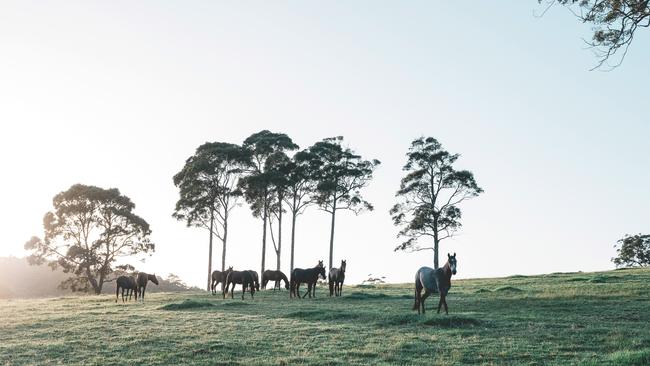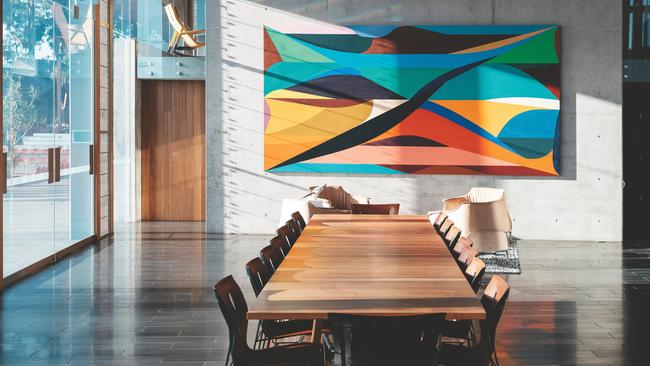Terry Snow is turning a quiet NSW hamlet into a global equestrian showcase
He’s regarded as an equestrian rock star so it’s no surprise Terry Snow is the man behind the world’s most impressively equipped equestrian centre and you’ll never guess where he built it.

Think of the Shoalhaven in southeastern NSW and what first comesto mind is pretty fishing villages, white sand coves, uncrowded surf breaks sometimes shared with kangaroos, wineries and cellar doors, and gourmet retreats such as Bannisters at Mollymook.
The image you might not conjure up immediately is cowboys. And yet, on a certain weekend each year, cowboys by the hundreds gather there for Australia’s richest prize in campdrafting, a little-known sport beyond the bush in which a mounted rider wrangles a beast through a winding series of pegs to display his horsemanship.
At each event, among a sea of Akubra hats roams a tall, unassuming, silver-haired man who is greeted like a rock star. In horsey circles he is. Terry Snow, 78, is the driving force behind Willinga Park, one of the world’s most impressively designed and equipped equestrian centres, which has risen over a decade on a sprawling 1000-hectare parcel of bushland outside the bucolic hamlet of Bawley Point, 180km from Canberra.
The massive complex includes three Olympic-sized dressage arenas, a warm-up arena, a show-jumping and polocrosse field, a campdrafting stage, 32 luxury stables, a heated equine therapy pool, a veterinary hospital, conference centre, housing for staff, and 18 lofty pavilions to accommodate riders and corporate sponsors. It’s all set in gardens dotted with sculptures and splashing waterfalls. The cost to date? More than $100 million. “All financed by me,” the billionaire philanthropist says proudly. “I haven’t got a cent from the government.”
“Mindboggling,” says Robert Harrisson Schmerglatt, a highly regarded equestrian and dressage coach who has lived and competed in Europe in the past few years. “I’ve seen some very impressive places, but I’d never seen a place like that before, expressly and purposely built just for this,” he says. Its sheer size and the attention to detail has created “excitement, amazement, astonishment that someone is willing to inject so much money not just into the horses, but trying to promote the sport”, he adds.

In many ways Snow is an unlikely patron saint of horse sports. In Canberra, where the son of a publican was born, he’s known as a canny real estate developer, the man who bought the run-down Canberra airport in 1988 and developed it into a first-class facility and hotel, “the best little airport in the world”. In person, he has a twinkling, laconic sense of humour. As a kid he was a “ratbag”, he says, and was channelled into accountancy before he got bored with that and moved into real estate, which he saw as more creative.
All his projects, from the solar-powered Canberra housing subdivision Denman Prospect to the grassy arenas of Willinga Park, are distinguished by his insistence on quality and love of art, especially sculpture, of which he is an avid collector. “Good art makes a difference,” he says. “It makes you stop and reflect. People know you care for what you do when you go to the trouble of putting in a nice piece of art.’”
Snow discovered the property in 2002 when he was looking for somewhere to land his helicopter near the family’s coastal holiday home. He bought a chunk of it and has been lovingly adding to it ever since, starting with a striking contemporary house designed by Canberra firm DJAS Architecture for himself and his wife, Ginette, a keen photographer of horses. He engaged Cox Architecture to carry out his grand vision for the horse park. Nothing has been spared in terms of cutting-edge technology, such as an irrigated sand and fibre dressage surface that’s kinder on horses’ hooves.
The streamlined buildings draw on local resources such as sandstone and blackbutt timber. And concrete (he loves concrete). It’s also powered by solar energy stored in a giant Tesla battery which, he says, is the largest battery under cover in the world. ‘We try to be as green as we possibly can. It makes sense.’
He almost lost it all in Christmas 2019 when the apocalyptic Currowan bushfire tore through the region. The fact the property was saved he puts down to good environmental practices. “I predicted that we were going to have this mammoth fire about two weeks before it came. We removed all the undergrowth, the fire came and it didn’t come onto our property at all. The odd tree would start to light up and we’d put that out.” He rescued a number of livestock from other farms, and the property formed a kind of fire break that helped halt the ravaging flames in the surrounding landscape.
Snow is one of Australia’s most generous, but quiet, philanthropists. The Snow Foundation has distributed $28 million over the years to community organisations around Canberra and the Snow Medical Foundation provides fellowships for promising biomedical researchers and their teams. Willinga Park is philanthropy for the horse world.

Why horses? He rode as a young man and did a bit of mustering around Canberra. Then 18 years ago he rode part of the Bicentennial National Horse Trail, which stretches from Cooktown to Healesville, and became enamoured with the Australian stock horse, a breed he says is “very good for endurance and quick-witted” and therefore easy to ride. “I got suckered into breeding,” he says of the extensive program to breed the horses under way at Willinga. But he doesn’t sound too unhappy about this – he recently sold a mare for $75,000 (they usually fetch $20,000).
Snow is most excited about the Volkswagen World Championship Gold Buckle Campdraft held at Willinga each May, for which he offers $286,000 in prize money. It draws huge crowds from all over Australia. His plan is to elevate the sport and improve the quality of horses and riders. It’s clear what he loves best about it, though. “It’s more about the day out than the horse event,” he says. ‘The whole family participates. The kids are razzing around on bikes, Mum’s talking to her girlfriends, people are catching up. They’re quite social occasions.”
Willinga hosts show jumping, dressage and rodeo competitions and the plan is to open the park to the public when there’s not a competition on. Guests will be able to get some equine therapy of their own, bike the bush tracks and enjoy the gardens and sculpture park. Ultimately, it will also include a luxury retreat. Snow says he’s looking for a “high-quality” chef before he takes this step. (Matt Upson from Gwylo in Mollymook caters events at Willinga.) He’s also working with South Coast neighbour, designer and event planner Collette Dinnigan on a “surf and stables” experience that includes a campdraft training session involving bison (a rare opportunity to use Dinnigan and bison in the same sentence).
Snow continues to tinker with his passion project, as he walks the property every day with his six dogs. An artist in residence precinct with studio is in the planning stage, although he sent the drawings for a building to house it back to the architects. “It was right over the top,” he says drily.
Terry and Ginette have four children and 12 grandchildren. “The grandkids love coming here,” he says, but he laments the fact his children have their own interests away from the park. “I don’t know where it goes after my passing,” he says. “I didn’t build it for a big legacy, but it will be here forever. It’s concrete!”
